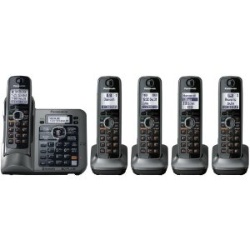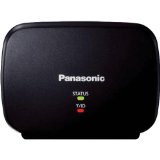
|
|||
|
|
|||
Cordless Phone Reviews and Ratings - Home: > This Page
Cordless phone frequencies are an excellent starting point when comparing cordless phones. It's the key to identifying superseded products and those that are more susceptible to problems. As a general rule the latest and best cordless phones are DECT 6.0 phones and use the 1.9 GHz frequency. DECT 6.0 Phones RuleA quick review of the Best Sellers confirms the extent to which DECT 6.0 phones have superseded all other cordless phone technologies. They comply with an international standard and give consumers to have confidence in their performance. Top Selling Cordless Phones DECT technology is responsible for the popularity of the 1.9GHz and the 1.8GHz cordless phone frequencies. (Outside the U.S. DECT cordless phones use the 1.8GHz frequency). The popularity of DECT can be attributed to factors including its: enhanced security, low power consumption, excellent range and advanced digital features. For some years the top rated cordless phones have all been DECT 6.0 phones. While the advent of DECT technology took the commoditization of cordless phones to a new level it would be a mistake to assume that all DECT phones are the same. Panasonic in particular has introduced many features that differentiate it's DECT phones from the rest. It continues to add features including call blocking, silent mode, extended range, power backup ... to its latest phones. By introducing these features Panasonic can compete and win without always having to be concerned about whether or not it has the cheapest cordless phones. There are still millions of 5.8 GHz, 2.4 GHz and 900 MHz phones in use, but few if any are still being manufactured. Once consumers discovered DECT 6.0 phones they stopped buying the alternatives. Not only do they perform better, they are also cheaper. The arrival of DECT 6.0 technology also coincided with significant falls in the cost of cordless telephones. Long Range Cordless Phones
The best long range cordless phone for use around the home or office are the latest generation of Panasonic cordless telephones designated DECT 6.0 Plus phones. Their range is up to twice that of standard DECT 6.0 phones and if that's not enough one or more range extenders An optional range extender can also be added the latest Uniden cordless phones including the DECT4000 2 line cordless phones. ATT's SB67118 was the first DECT 6.0 four line cordless phone. It can be configured with multiple range extenders. They give enormous coverage as well as overcoming issues with blind spots. Other Cordless Phone FrequenciesBecause of the way in which the FCC allocates cordless phone frequencies, each is associated with a generation of cordless technology. 900 MHz Cordless PhonesThe 900MHz frequency was allocated in 1990 when analogue phones were at the bleeding edge of cordless technology. They were basic and could only connect with a single cordless handset. The 900 MHz spectrum rapidly became crowded and users complained about cordless phone interference. Their phone calls could also be hacked. Neighbors with a scanner could easily tune in and eavesdrop on calls. Sanyo and Sony cordless telephones were some of the best 900 MHz phones in their hay day. Rather than invest in DECT 6.0 technology they evidently decided to pursue other opportunities in consumer electronics. Ultra Long Range Cordless Phone
900 MHz phones deliver excellent cordless phone range. For this reason they are still used in rural areas, car yards, entertainment complexes, construction sites etc. Essentially anywhere that cell phone coverage is poor or non-existent. Engenius phones 2.4 GHz PhonesThe 2.4GHz frequency was allocated in 1998 when the 900MHz frequency had reached saturation. It heralded the introduction of digital technology, FHSS (Frequency Hopping Spread Spectrum), increased security and multiple handsets sharing a single base unit / landline. The 2.4 GHz frequency rapidly became saturated as well. It's used by WiFi networks and many other wireless enabled devices. The up-shot was that cordless phones acquired a reputation for poor voice quality, interference, break-up and drop-outs. 5.8 GHz PhonesThe 5.8MHz frequency was allocated in 2003. While it's not restricted to voice communication, it's relatively uncluttered and interference is seldom a problem. The phones use digital technology and calls are relatively difficult to eavesdrop, however they do have other issues. 5.8GHz phones draw more power than those using other cordless phone frequencies. Users complain about the need to constantly recharge handsets even after relatively short phone calls. To overcome these issues some manufacturers have designed their phones to only use the 5.8GHz frequency for communication from the base to the handset. On the return journey they use the 2.4 GHz frequency. It enables them to hold a charge for longer, but at the expense of using a congested frequency. SummaryToday consumers need no longer study the ins-and-outs of cordless phone frequencies when hunting for the best cordless phones. With few exceptions the top rated cordless phones are DECT 6.0 phones using the 1.9 GHz frequency. Cordless Phone Frequencies - Related Cordless Phone ReviewsHow to Compare Cordless Phones - where to begin? The Best Home Phone - it's a cordless phone. but which one? |
|
||
|
|
|||
|
|
|||
|
| |||
